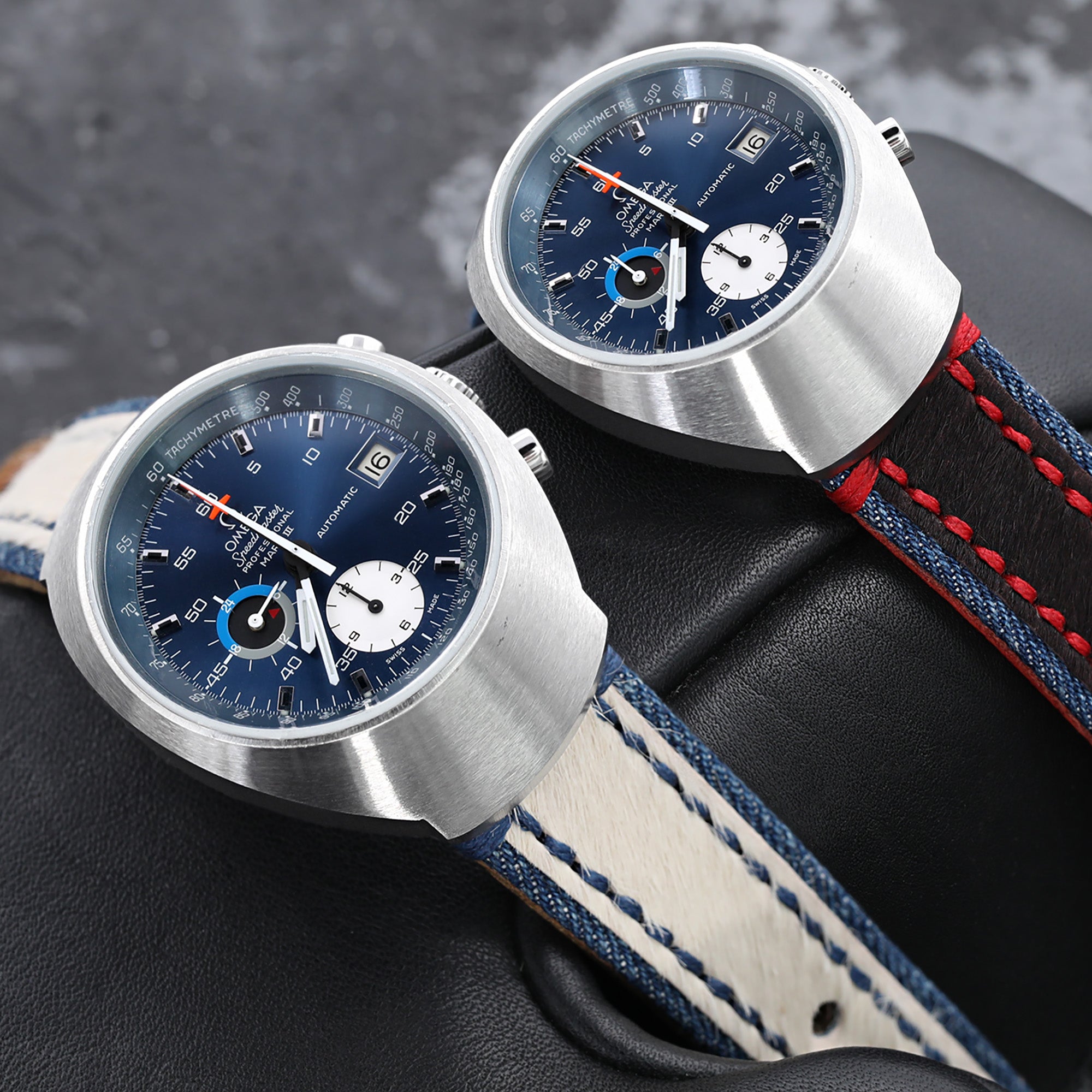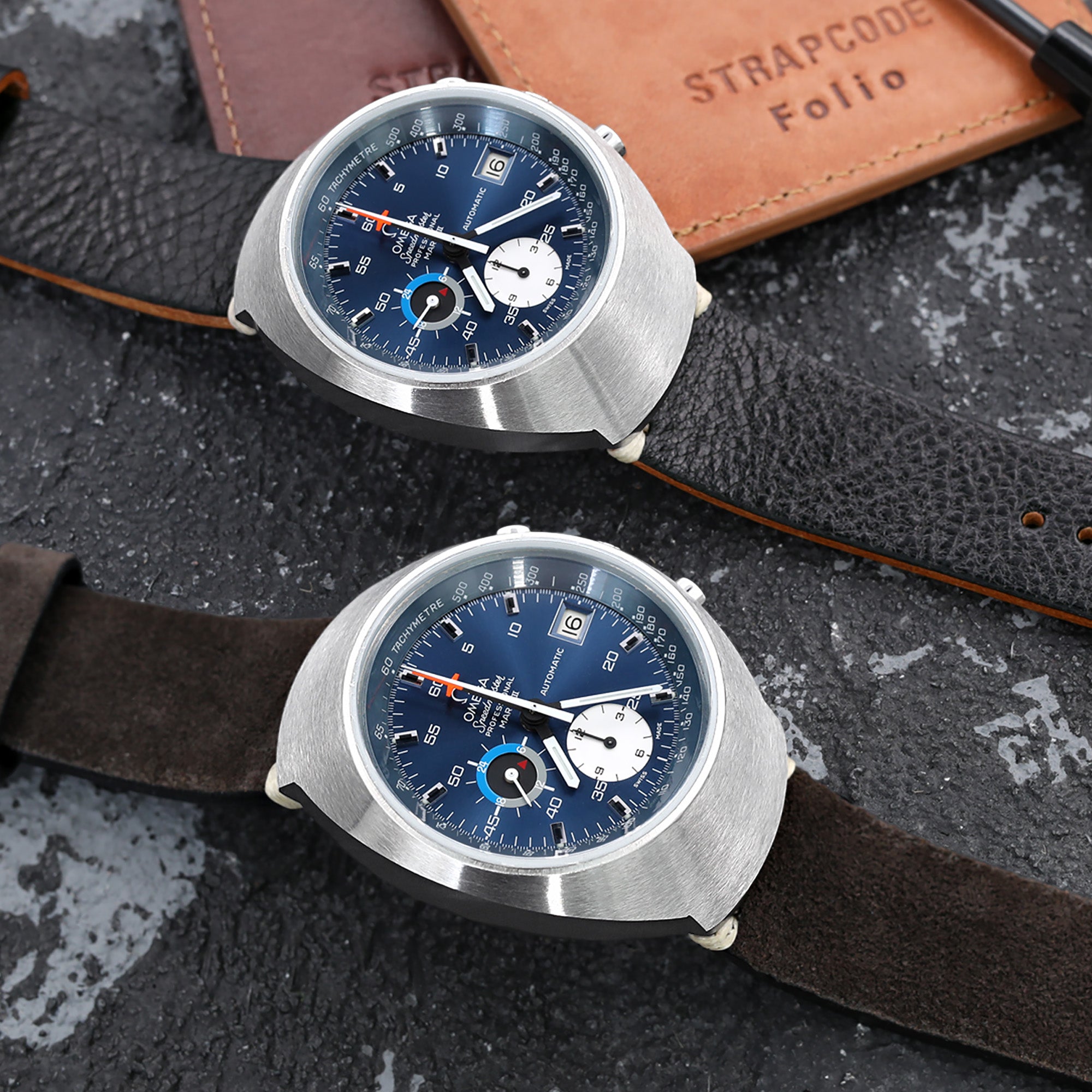Giants of the vintage watches: Vintage Omega Speedmaster Mark 3

Omega moon watch - three generations, from Left : Speedmaster Mark 1, Mark 2 & Mark 3 vintage advertisement, image source : fratellowatches.com
When it comes to vintage watches, Omega leads one of the main roles through the history of timepieces. Today we’re going to explore on of its most odd and larger chronographs: Mark 3, from the Speedmaster collection.
But let’s us first tell the Omega story briefly. Omega stands for Swiss luxury brand among the watchmakers for more than a century and a half. It is founded in 1848 under name La Generale Watch Co and changed its name to Omega at the start of XX century. In 1917, British Royal Flying Corps chose Omega as the official watches for their combat units and U.S. Army did the same a year later. But more famous information is that Omega was the first watch on the moon, in 1969, so it’s no wonder that Omega watches appear in the movie "First Man", about the life of Neil Armstrong. Omega is also the official timekeeper of the Olympic Games since 1932. But the game doesn’t stop there... Since 1995, James Bond wears only Omega watches so it doesn’t wonder that Omega is a favorite watch brand of many famous persons such as: Elvis Presley, George Clooney, John F. Kennedy etc.

Vintage advertisements of Omega Moon watch, image source : millenarywatches.com
Omega has many famous watch series, such as Constellation, Seamaster, De Ville, Speedmaster, plus Specialties collection that contains watches made for Olympic Games and other special editions. While we’ll probably explore many of their watches, let’s focus on Speedmaster series for a bit.
Omega Speedmaster series is introduced in 1957 as racing and sport chronographs. Although Speedmaster wasn’t originally designed for space activities, probably the most famous watch from this collection is Speedmaster Professional or, so called,"Moonwatch" worn by NASA astronauts during the first walk on the Moon. This same"Moonwatch" is actually the first of the Mark series that contains 4 chronographs, although it’s almost never called by its real name. Mark II appeared as a variant on Mark I, in 1969 and was actually the first of Marks that was available to the wider public.

Omega Speedmaster Mark III showcased with 20 mm MiLTAT Italian Handmade Racer Vintage Blue Watch Strap, Yellow Stitching 22D18PBU63R1B25
Mark III was introduced in 1971, as a self-winding Speedmaster and marks the first use of caliber 1040a movement (so called Lemania caliber 1341, along with caliber 1041, also used in Mark III), a product of Lemania and Omega. Mark III was discontinued in 1973 (from 1974, the 176.x reference number no longer appears in production year lists) and the same year Omega introduced its successor, Mark IV with the same movement as Mark III but with some elements from Mark II (case with slightly modified bezel).There was also a fifth watch in Mark series, Mark V introduces in 1984, but it was made only for central European (German speaking countries).

MiLTAT Zizz collection watch strap combined with fur, demin & calf, left 22E20BIW01C1U04 & right 22N20BIW01C1C17
Omega Speedmaster Mark III has three distinctive case styles: one with Flightmaster lookalike steel case (Automatic and Pro, available with at least three different dials), one with Seamaster-type case (steel and gold plated) and another with TV Dial Seamaster steel and gold plated case.
As for the first variant with the case similar to Flightmaster, three dial colors were available: black, navy blue and silver. The other variant with the case similar to Seamaster series had the blue dial, but pictures of some custom variations can also be found around the web. The third variant, with Seamaster case had the square blue dial, but there are also some custom variants with grey (super rare!) and gold dial.
There were also some variations in bezels among Mark III’s, which brings even more fuzz around them.

More classy look with MiLTAT leather collection : top 22P20EBU57C1A72 & bottom Nubuck 22P20EBU57S6C41
The caliber 1040 movement is actually not rated as chronometer movement but it was replaced with caliber 1041 in 1973, and that is way some Mark III’s are marked as professional and some are not. For example, the first variant of Mark III, the one with the case similar to Flightmaster have either "Omega Automatic Speedmaster Mark III" or the "Omega Speedmaster Professional Mark III Automatic" marked on the dial, where one of the explanations is that those which are not marked as"Professional" are launched in 1971 and 1972, while those manufactured in 1973 and after had the former.
While Mark III’s stand for exceptionally big cases made to protect this weird chronograph (with its diameter of 13 ¾ lines), they are also among the heaviest, not just in 70’s watches but among Omega watches in general, with their weight of more than 157 grams!
The Mark III big case is housing central 60 minutes counter, stopwatch counting a minute in 1/5ths of a second, a 12-hrs counter, a double counter ( seconds counter and a 24-hrs dial) and a date.

22mm Tapered Milanese wire mesh watchband MB2218FYB043 to match its steel case
Although many function improvements were tested with time, not so much has changed in Speedmaster modern series from the vintage era since none of them went into the wider use. The main differences between vintage and modern Speedmaster watches available on the market are mostly in the details. The bezel has somewhat different writing than before and modern dials are flat, while the vintage have the so called"step" on their glass etc.
While its case is quite big, it can have any 20 mm watchstrap attached on its back, without the annoying gap in between, which allows you to dress this magnificent weirdo any way you want. However you do it, we’re quite sure this giant will attract attention wherever you go.
Written by M.H. , Photo by Toni
For more information:
Continue to read the Omega Watches Series |
|
|
|
|
|
|
|
|

